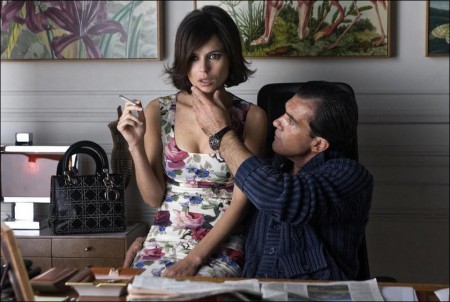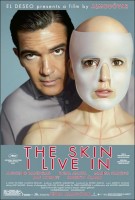Ever since his wife was burned in a car crash, Dr. Robert Ledgard, an eminent plastic surgeon, has been interested in creating a new skin with which he could have saved her. After 12 years, he manages to cultivate in his own laboratory, a skin that is sensitive to caresses, but a real shield against all the aggressions, both external and internal, to which our largest organ is submitted. To obtain it, he has used the possibilities provided by cellular therapy.
In addition to years of study and experimentation, Robert needed a human guinea pig, an accomplice and no scruples. Scruples were never a problem, they weren’t part of his character. Marilia (Elena Anaya), the woman who looked after him from the day he was born, is his most faithful accomplice. And as for the human guinea pig…
Over the course of each year, dozens of young people of both sexes disappear from their homes, in many cases of their own will. One of those young people will end up sharing the splendid mansion, El Cigarral, with Robert and Marilia, and will be doing so unwillingly.
About The Skin I Live In
There are irreversible processes, roads of no return, one way journeys. The Skin I Live In tells the story of one of those processes. The protagonist travels one of those roads against her will, she is forced violently to set out on journey from which she cannot return. Her Kafkaesque story is the result of a sentence handed out by a jury made up of just one person, her worst enemy. The verdict, therefore, is a form of extreme revenge.
The Skin I Live In tells the story of that revenge. The first images in the film are of a mansion surrounded by trees, an idyllic place. It’s called El Cigarral and it’s protected by stone walls and a high barred gate. Through one of the mansion’s windows, also barred, we can make out a female figure in motion.
Once we are inside the room, the woman seems to be naked as she carries out a series of yoga positions; in the close-ups we discover that she isn’t naked, she is totally covered by a flesh coloured body stocking that clings to her like a second skin. In the kitchen, Marilia, the housekeeper, prepares the woman’s breakfast which she then sends up in a dumb waiter that opens directly onto the room.
From the outset, El Cigarral is portrayed as a prison in the midst of nature. An isolated place, inaccessible to eyes on the outside. The first actions that show us Vera, the captive woman concentrating on her yoga positions, and Marilia, her jailer, seem strangely routine, lacking in any tension. But life in El Cigarral wasn’t always so peaceful. In her six years of enforced reclusion, Vera has lost, among other things, the most extensive part of the human body, her own skin. Literally, she has shed her skin along the way.
Skin is the frontier that separates us from others, it determines the race to which we belong, it reflects our emotions and our roots, whether biological or geographical. Many times it reflects the state of the soul, but skin isn’t the soul. Although Vera has changed her skin, she hasn’t lost her identity. (Identity and its invulnerability is another of the film’s themes).
In any case, the loss of one’s skin is atrocious! This is only one of the many losses that leave Vera on the verge of death, by her own desire or in the operating theatre, at the hands of Dr. Robert. But she is a born survivor and, after many difficulties, she decides that “she has to learn to live within her skin”, even if it is a skin imposed by Dr. Robert. Once she has accepted her second skin, Vera takes the second most important decision in order to survive: she’ll learn to wait.
Elías Canetti, in his notes on “The Enemy of Death” (a title that defines very well Vera’s attitude to life) from his “Book of Dead People”, writes: “…the uninterrupted pacing of a tiger behind the bars of its cage so that it won’t miss the single, fleeting instant of salvation”
Curiously, that brief instant to which Canetti refers comes to Vera in the form of a tiger, or rather, a man wearing a tiger costume. One day, during Carnival, a man in a tiger costume manages to get to the hermetically sealed door of the room where Vera is held captive. This incident breaks the impasse in which the three residents of El Cigarral have been living. Paradoxically, given the customs of Carnival, this is the moment when the characters remove their masks and the final tragedy casts its black shadow without any of them being able to do anything to prevent it.
A story of these characteristics made me think of Luis Buñuel, Alfred Hitchcock, all of Fritz Lang’s films (from the gothic to the noir). I also thought of the pop aesthetic of Hammer horror, or the more psychedelic, kitsch style of the Italian giallo (Dario Argento, Mario Bava, Umberto Lenzi or Lucio Fulci…) and of course the lyricism of Georges Franju in Eyes Without a Face. After evaluating all these references, I realized that none of them fitted with what I needed for The Skin I Live In. For some months I thought seriously about making a silent film, in black and white, with captions which showed descriptions and dialogue.
And paying tribute to Fritz Lang and Murnau. After doubting for months, I decided to go my own way and let myself be carried along by intuition, after all, it’s what I’ve always done, without the shadow of the maestros of the genre (among other reasons because I don’t know to what genre this film belongs) and renouncing my own cinematic memory. I only knew that I had to impose an austere narrative, free of visual rhetoric and not at all gory, even though a lot of blood has been spilled in the ellipses that we don’t see. It isn’t the first time I’ve started from this premise before shooting, but I think that The Skin I Live In is the film where I have got closest to it.
I’ve been accompanied on this journey by José Luis Alcaine, the director of photography, to whom I didn’t explain what I wanted but rather what I didn’t want, and he knew how to give the photography the density, the glow and the darkness that suited it best. The musician Alberto Iglesias, the only artist I know without an ego, tireless, versatile, patient, capable of looking in one direction and then looking in the opposite direction if I wasn’t satisfied, always subject to the dictates of the story and my way of feeling it. And actors who were generous and precise, despite the obvious discomfort of some of their scenes. I’ll name them all: Antonio Banderas, Elena Anaya, Marisa Paredes, Jan Cornet, Roberto Álamo, Blanca Suárez, Eduard Fernández, Susi Sánchez, Bárbara Lennie and José Luis Gómez.
The Skin I Live In
Directed by: Pedro Almodovar
Starring: Antonio Banderas, Elena Anaya, Marisa Paredes, Jan Cornet, Blanca Suarez, Susi Sanchez, Eduard Fernandez
Screenplay by: Pedro Almodovar
Production Design by: Antxón Gómez
Cinematography by: José Luis Alcaine
Film Editing by: José Salcedo
Art Direction by: Carlos Bodelón
Set Decoration by: Vicent Díaz
Costume Design by: Paco Delgado
Music by: Alberto Iglesias
MPAA Rating: R for disturbing violent content including sexual assault, strong sexuality, graphic nudity, drug use and language.
Studio: Sony Pictures Classics
Release Date: October 14, 2011
Hits: 77






